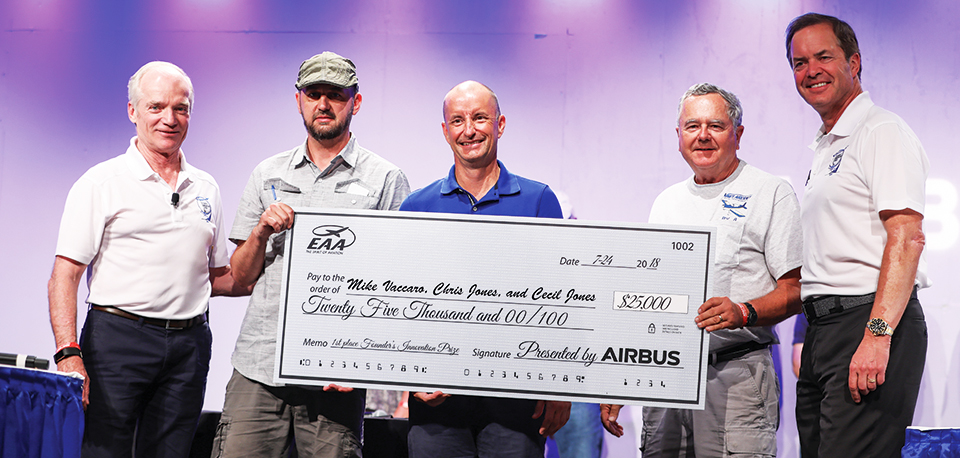Aural Angle of Attack Project wins Founder’s Innovation Prize
By Randy Dufault
July 25, 2018 - Mike Vaccaro, Chris Jones, and Cecil Jones’ proposal for solving loss of control situations was deemed Tuesday night’s winner of the 2018 Founder’s Innovation Prize. With the win, their project, titled Enhanced Aural AOA Logic, gets a monetary boost of $25,000. The cash prize, sponsored by Airbus, is to help the team further develop and test the concept and, ideally, make it commercially viable.
Built as an open-source software system that connects to any calibrated angle of attack data source, the software provides audio cues during certain flight regimes, like takeoff and landing, regimes that have a high potential for loss of control situations.
“From an energy management standpoint, whether you are maneuvering, or taking off, or landing, there is never a requirement to ever pull any harder than on-speed,” Mike, EAA 152409, said. “If you do you are just bleeding energy unnecessarily, you are not getting any additional performance, you are eating up your aerodynamic margin, and walking closer to the stall.”
“There’s a lot of AOA products out there already,” Chris said. “We’re not trying to go and create a new one, we’re just trying to take that information and give it to you in what we think is a more usable form.”
Since it provides audio cues, the team calls it a head up, eyes out solution.
A team of judges, composed of former space shuttle commander Charlie Precourt, Embry-Riddle Aeronautical University’s Pat Anderson, former NTSB investigator Gregory Feith, renowned civilian test pilot Dave Morss, and Van’s Aircraft founder Dick “Van” VanGrunsven, selected the winner after the aural AOA team and the other four finalists presented their projects to an audience at Theater in the Woods.
Olga Custodio, the first Hispanic female to complete U.S. Air Force undergraduate pilot training, emceed the event.
Ken Hall received a second prize of $10,000 for a project that he calls The Virtual Co-Pilot. Using the processing power of a smartphone, a simple wireless air data sensor, substantial amounts of environmental data, and artificial intelligence, Ken’s solution delivers constant visual, verbal, and haptic energy state feedback to the pilot.
The third prize of $5,000 went to the team of William Hinks, EAA 186485; Mark Spatz, EAA 1205192; and Naser Al Madi, EAA 1277056, for their submission An Angle-of-Attack Sensor in a Smartphone?
Rounding out the group of five finalists were runners up Jack Hohner, EAA 170715, with his project FeelFlight Grip, and the team of Ray Kwong, EAA 1250962, and Ray Bracy, EAA 1278116, with the Epic Eagle head-up display.
The judging team spent a tremendous amount of time sorting through and ranking submissions in order to select the five finalists.
“Frankly, I think what we were looking at is that they are all really close,” Charlie said. “Their strengths were in concepts that were rational and intriguing, and well thought out.”
In what could be a clue for those considering entries in next year’s contest, Charlie added, “Their weaknesses in general were a lack of flight test data. What I mean by that is we really want to see more development, see that folks have taken it further than conceptual. There are a couple that did that.”
Applications open for the 2019 contest soon. Details are available at www.EAA.org/prize.

